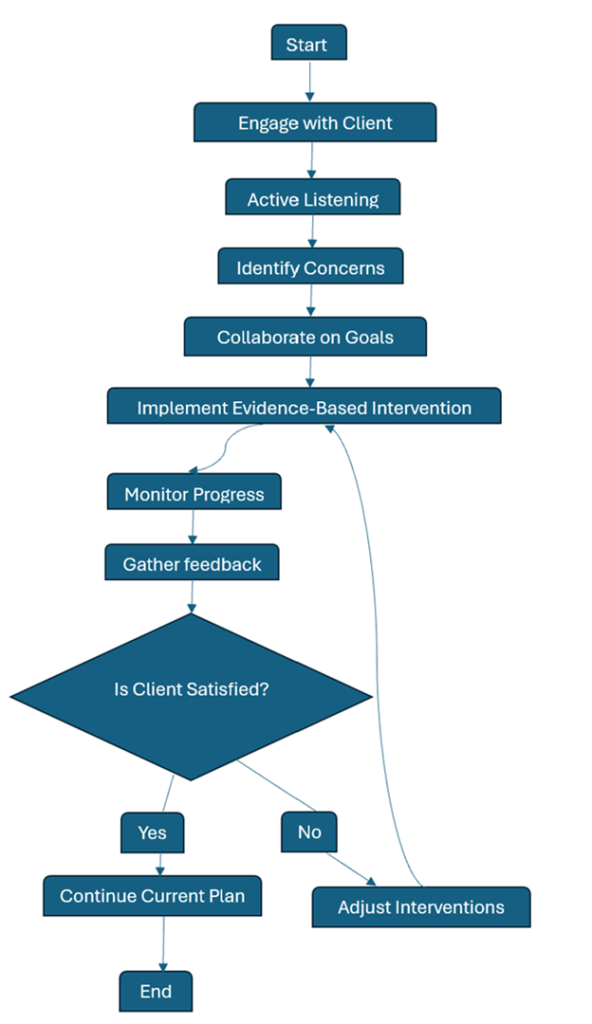Compassionate Care in Applied Behaviour Analysis (ABA)
In the dynamic field of healthcare, particularly within behavioural sciences, the concept of compassionate care plays a crucial role. As practitioners in Applied Behaviour Analysis (ABA) strive to improve the lives of their clients, integrating compassionate care into their practices is vital. It should become a cornerstone of their work. However, “compassionate care” is often misunderstood, leading to misconceptions about its true nature and application. This article attempts to clarify the essence of compassionate care in ABA, outline its core principles, and provide a comprehensive process flow diagram to illustrate its practical application.
Compassionate care is overarching; it bridges technical intervention and the human experience, leading to stronger bonds and better results. To ensure client engagement, satisfaction, and overall quality of life, behaviour analysts must create a therapeutic environment that allows clients to feel supported and understood.
What is Compassionate Care In ABA
Compassionate care is defined as the recognition, empathic understanding, and emotional responsiveness to the pain, distress, or suffering of others as motivation to act and change these conditions (Lown et al., 2016). In the context of ABA, this means actively engaging with clients and their families to understand their needs and concerns while implementing effective interventions. It requires behaviour analysts to apply technical skills and connect with their clients on an emotional level.
Common Misconceptions About Compassionate Care
Compassionate care is often misconstrued and misunderstood as synonymous with permissiveness or a lack of structure. This can lead to the belief that compassion entails allowing clients to dictate their treatment or avoiding challenging conversations. In fact, the answer is quite the opposite because compassionate care is about creating a supportive environment where clients feel heard and valued while ensuring that therapeutic goals are met through evidence-based practices.
Compassion Equals Permissiveness: Some people may believe that compassion means letting clients have their way. However, genuine compassion entails respecting clients’ feelings while assisting them in making better decisions.
Avoiding Difficult Conversations: A common misconception is that compassion entails avoiding difficult conversations. In fact, compassionate care often necessitates having those challenging talks in a constructive and supportive way.
Lack of Structure: Compassionate care incorporates empathy into a structured intervention framework, not a lack of structure.
Principles of Compassionate Care in ABA
1. Empathy and Active Listening
Empathy, a foundational component of compassionate care, is a powerful tool for behaviour analysts. By actively listening to clients and their families, acknowledging their feelings and concerns, and maintaining an open dialogue, behaviour analysts can foster a deeper understanding and connection with their clients. This approach, based on what the client is expressing vocally and non-vocally, allows the client to remain in control as much as possible (Taylor et al., 2019).
Active Listening Techniques
Maintain Eye Contact: Clients need to feel they have your full attention.
Nod and Use Affirmative Gestures: Non-vocal cues can convey understanding and encourage clients to continue sharing.
Repeat What You Hear: repeat short statements by clients so you can be sure of what they mean and let them know that you empathize with their feelings.
Ask Open-Ended Questions: Questions that cannot be answered with a simple “yes” or “no” encourage deeper conversation and exploration of feelings.
2. Collaboration
Effective treatment in ABA requires a collaborative approach. By fostering a partnership between behaviour analysts, the client, and the family, interventions can be tailored to the client’s needs and preferences, ensuring their commitment and the success of the treatment.
Strategies for Collaboration
Engage Family Members in Goal Setting: Involvement of family members in treatment planning can help ensure that interventions are effective.
Regularly Update Clients on Progress: Telling clients about everything you do enables transparency and trust.
· Encourage Family Insights: Family members frequently offer insightful opinions that can improve treatment efficacy.
3. Evidence-Based Practices
Compassionate care must be grounded in evidence-based practices. Behavior analysts should utilize effective interventions that respect the client’s dignity and autonomy. This includes avoiding overly intrusive procedures and emphasizing positive reinforcement (Penny et al., 2023).
Examples of Evidence-Based Practices of Compassionate Care
Positive Reinforcement Strategies: Reinforcers (rewards) will positively influence an individual’s behaviour.
Data-Driven Decision-Making: Regular data collection and analysis enables behaviour analysts to evaluate the success of interventions and make the required modifications.
4. Continuous Feedback and Adjustment
Compassion in the sense of care calls for ongoing assessment and readjustment of interventions based on client feedback. The treatment team should always meet regularly to assess for effectiveness by behaviour analysts who practice client-centred care (Denegri et al., 2023).
Feedback Mechanisms
Structured Interviews: Conducting interviews to obtain client feedback on the treatment can be an incredibly valuable source of information.
Surveys: Administer satisfaction and perceived effectiveness surveys to inform adjustments in treatment.
Regular Team Meetings: Reviewing client progress with team members helps to adapt strategies and problem-solve.
The Role of Compassionate Care in Enhancing Client Outcomes
Better-quality Therapeutic Relationships
Compassionate care significantly enhances the therapeutic relationship between behaviour analysts and clients. Clients who are cared for and listened to (rather than ignored) are likelier to engage in treatment, adhere to interventions, and communicate their needs openly. This builds trust and leads to better outcomes, fostering an optimistic and motivated environment.
Create Trust
Consistent Communication: Keep them updated and notify them of their care updates to ensure reliability.
Transparency: Being open about treatment processes and decisions can help build trust and compliance.
Increased Client Satisfaction
Clients who perceive their care as compassionate report higher levels of satisfaction. This satisfaction reflects not merely the treatment’s effectiveness but also how they feel treated throughout the process. It’s a validation of their experience and a testament to the appreciation they receive in compassionate care.
Factors Contributing to Satisfaction
Effective Communication: Clear and compassionate communication makes clients feel informed and involved.
Feeling Valued: Clients who feel their concerns are taken seriously are more likely to be satisfied with their care.
Long-Term Behavioural Change
Behaviour analysts can facilitate long-term behavioural change by integrating compassion into the therapeutic process. When clients are empathized with, it strongly internalizes the skills and strategies being taught and creates sustainable behaviour changes that are client goals and values-aligned agreements.
Sustainability of Change
Empowerment: Clients who feel supported are likelier to take ownership of their progress and apply learned skills in real-life situations.
Resilience: Compassionate care can help clients develop resilience, enabling them to navigate challenges more effectively.
Process Flow Diagram
Below is an ABA process flow diagram depicting the key steps for implementing compassionate care.

